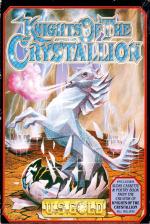
Zzap
 1st April 1990
1st April 1990
Categories: Review: Software
Publisher: U. S. Gold
Machine: Amiga 500
Published in Zzap #60
Knights Of The Crystallion
Many eons ago the most massive creature that ever lived roamed the oceans, swallowing whales in a single gulp. But one day its immense hunger led it up a river, to become beached and slowly die. The elements soon rotted away its flesh, leaving bones massive enough to enclose a city. In time, a tribe of humans found the bones and slowly went about creating that city.
The most important part of the skeleton is the skull, set aside for the priests who call themselves the Keepers of Tsimit. One of their many secrets is the knowledge that the brain had not rotted but fossilised instead, forming pulsing crystals. When combined they can produce dangerous beams of light. Some of the more powerful crystals can even create life, such as Crystallions. These crystal horses have incredible beauty and intelligence. They are companions for life, and only those who have bonded with one can sit at the city council.
To find your crystallion you must first find the well-hidden crystals. The quest begins with the Orodrid City Screen, a menu page with the icon-options rotating over the city scene. You must prove your worth at all the various subgames:
Tsimit: This is the most important part of the game, since it's here that the crystals are found. The Tsimit has four 'veils', or sections, each of which is completed by finding the door to the next. The Tsimit is a flick-screen maze, packed with monsters, and is shown at an angle from above. Control is via the mouse; move a cursor to the point where you want to move to or fire at, depending which mouse button you press. Protection is provided by a Crystallion Suit with three charges (or lives) - lose them all and it's game over.
Bosu: Once you've found the Tsimit exit door, you're challenged to a game of Bosu, a board game which you must win to get onto the next section. You have six stones to place on five rings split by eight rays. While difficult to describe in less than a couple of pages, it's fun to play and has two-player, difficulty and tutor options.
Proda: Should you lose a lot of charges/lives in the Tsimit you can use your crystals to earn more in this subgame. Three cylindrical 'prods' rotate at the centre of a 3D room. Using the mouse you can place crystals in special formations to collect bolts of energy. But watch out for the alien birds which try to steal the crystals.
Deketa: Some cards are dealt; face up at first with numbers from 1 to 8, then quickly flipped over. You must then click on two cards of the same value, using memory, 'ESP', and observation (as the numbers can occasionally be seen). Winning can give you special powers useful in the Tsimit.
Haresh: This is the trading part of the game; fail to earn enough to support your family and it's game over. Make lots of profits, and donations to the Tsimit priests might be useful. There are seven trading families, each involved in three trades ranging from meat and dairy products to books and songs. You must set the prices for your three types of goods, bearing in mind quality and competitor prices. You can also invest in opening markets in the wider world and make donations to families in trouble.
Phil
I think I now why this has such a bizarre scenario: it was the only thing which could possibly link together such diverse subgames. And, imaginative as it is, it still fails to really make the vastly different sections gel into one complete game.
Nevertheless, I was impressed by the very classy presentation with ever-changing, atmospheric music, 'Carling Black Label'-sounding sampled speech, and plenty of pretty pictures to ogle (although these do suffer in definition due to use of the HAM mode).
All the subgames are fairly playable - I particularly enjoyed thrashing Robin at the Bosu boardgame, even though I hadn't a clue what I was doing! And, overall, Knights has plenty of originality, variety, and a big challenge, although it isn't quite the mega-game it could have been.
St
So what, exactly, is a 'culture simulator'? It turns out to be a collection of oddball subgames surrounded by a better-than-average scenario. Presentation is indeed very weird, and (especially on the trading subgame) there's a good sense of an alien civilisation.
As for playability, all the subgames are quite enjoyable with some excellent graphics and sonics which are obviously designed for the Amiga, not the ST.
The most important game is Tsimit, an arcade maze game which, on the higher levels, improves graphically while using lifts to make virtually every screen a puzzle to be mapped.
If you like the sound of this, the other games provide some attractive variety. But if you hate mazes and maps, Knights could be very frustrating. Still, a very interesting game which solidly establishes US Gold as an innovative 16-bit producer.
Verdict
Presentation 90%
Great intro, poetical protection system, save option, and interlevel HAM pictures.
Graphics 84%
Full use is made of the Amiga's palette, with plenty of atmospheric HAM pictures, to produce a very weird and intriguing graphic style.
Sound 90%
Atmospheric music which varies constantly. Effective occasional use of digitised speech.
Hookability 76%
Difficult to get into and far from easy, but you can practise some of the sub-games.
Lastability 88%
Tsimit provides a big challenge, while keeping up with the other subgames provides variety.
Overall 79%
An intriguing and innovative game which cartographers will love.


